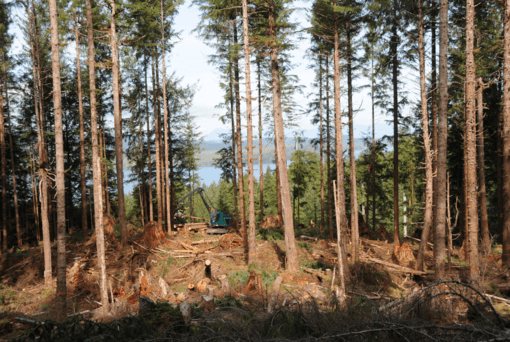
Photo by USDA Forest Service Alaska | CC BY 2.0
Every time I drive up to Mount Bachelor in Central Oregon I pass the Deschutes National Forest’s logging and mastication projects. The Forest Service and the Deschutes Collaborative suggest they are “thinning” the forest to preclude large wildfires and to “restore it.” (The collaborative is a working group of various stakeholders who advise the Forest Service about management issues.)
Neither of these assertions is accurate. What they are creating is tree plantations of largely even-aged trees — all done in the name of “fixing” the forest.
The first myth they are selling to the public is that logging can preclude large wildfires. There is a host of research — much by Forest Service’s own fire researchers as well as other ecologists — that concludes that under “extreme fire weather” nothing stops a wildfire.
When you have high temps, low humidity, drought and high winds, wildfires are unstoppable. It does not matter how much “thinning” or other fuel treatment you have done; wildfires will charge through, over and around any “fire break.”
When it appears that a fire break has stopped a blaze, check again. Almost always, the weather has changed. It is weather change, not firefighting, that allows humans to stop large wildfires.
I just visited the Thomas Fire in Southern California, the largest blaze in recent California history. Despite thousands of firefighters, and numerous fire breaks along the pathway of the fire, including 12-lane freeways, the only fire break that halted the Thomas Fire was the Pacific Ocean!
The only way to protect Bend and other communities is through mandatory firewise regulations that include nonflammable roofs, removal of flammable materials from near homes, and planning for rapid evacuation in the event of a wind-driven blaze.
The second justification for logging is to “restore” the forest. However, you can’t fix something if you don’t understand it. The Forest Service does not understand forest ecosystem function.
Logging trees reduces the potential for natural episodic mortality from other sources whether drought, beetles or wildfire that creates the dead trees and down wood critical for the survival of many species.
Indeed, the snag forests that result from major wildfire is one of the rarest habitats found in Western ecosystems. The second-highest biodiversity in our forest ecosystems is found the snag forests that result from high-severity fires or beetle kill.
For these plants and animals, the worse condition is what the Forest Service terms are a “healthy forest” with green trees.
Logging also can affect the genetic diversity of the forest. No foresters with a marking paint gun can tell which trees have the genetic diversity to sustain our forests. Natural ecological processes like wildfire or drought are superior at picking the winners and losers that will provide resilience for future forests.
Forests are among our best forms of carbon storage. Numerous studies have shown that even burnt forests retain more carbon than logged/thinned forests. What burns in a wildfire are the fine fuels like needles and small branches. That is why we have “snags” after a fire. And most of the original carbon is retained in those snags and in the soil. Indeed, there are some ecologists and economists who insist the highest and best use of our public forests is to leave them alone for their long-term carbon storage value. But you won’t hear this from the Forest Service or Deschutes Collaborative.
And this gets to the third reason logging can’t “restore” the forest. We are in the midst of an unprecedented and accelerating climate change. Which plants and animals will live in Central Oregon and what the composition of the forest will be like 50 or 100 years from now is impossible to determine. What we need to do is allow natural evolutionary processes to create the resiliency that will enable forests to meet future climate challenges, not some guy with a chainsaw.